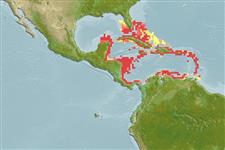Environment: milieu / climate zone / depth range / distribution range
Écologie
marin; profondeur 0 - 50 m (Ref. 189). Tropical; 28°N - 7°S, 90°W - 60°W (Ref. 189)
Western Central Atlantic: southern Florida (USA), Cuba, Bahamas, Greater and Lesser Antilles, and Yucatan, Mexico to Venezuela; not in Gulf of Mexico; Trinidad south to Guianas; possibly Brazil.
Taille / Poids / Âge
Maturity: Lm ? range ? - ? cm
Max length : 12.0 cm TL mâle / non sexé; (Ref. 5217); common length : 10.0 cm TL mâle / non sexé; (Ref. 5217)
Épines dorsales (Total): 0; Rayons mous dorsaux (Total): 14-15; Épines anales 0; Rayons mous anaux: 19 - 26. Somewhat compressed. Snout pointed, about 3/4 eye diameter; maxilla pointed, long, reaching to hind border of pre-operculum; walkeri-type gill cover canals. Anal fin origin below about midpoint of dorsal fin base. Anus advanced, nearer to pelvic fin tips than to anal fin origin. Silver stripe along flank with a dark line above, expanded over anal fin, about 3/4 eye diameter (Ref. 189). Back gray, top of head iridescent. Melanophores evenly scattered on back, forming a middorsal line, especially rearward (Ref. 7251).
Occurs in coastal waters, forming dense schools. Not entering the mangrove-lined lagoons of the Venezuelan mainland, but is the dominant species of the Los Roques Archipelago off Venezuela and there found as much in the lagoons as outside them. Frequently caught in mixed schools (with A. mitchilli) in the Miami area. Feeds on zooplankton. Ripe females recorded off Florida in June and July. More data needed.
Life cycle and mating behavior
Maturité | Reproduction | Frai | Œufs | Fécondité | Larves
Spawn in school (Ref. 205).
Whitehead, P.J.P., G.J. Nelson and T. Wongratana, 1988. FAO Species Catalogue. Vol. 7. Clupeoid fishes of the world (Suborder Clupeoidei). An annotated and illustrated catalogue of the herrings, sardines, pilchards, sprats, shads, anchovies and wolf-herrings. FAO Fish. Synop. 125(7/2):305-579. Rome: FAO. (Ref. 189)
Statut dans la liste rouge de l'IUCN (Ref. 130435)
Warning: mysqli::__construct(): (HY000/1040): Too many connections in /var/www/html/includes/func_getlabel.php on line 46
Can't connect to MySQL database (fbapp). Errorcode: Too many connections
